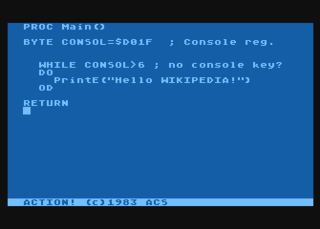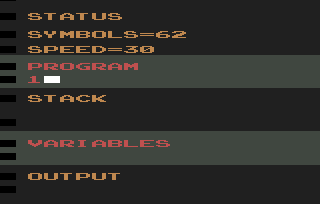Applesoft BASIC is a dialect of Microsoft BASIC, developed by Marc McDonald and Ric Weiland, supplied with the Apple II series of computers. It supersedes Integer BASIC and is the BASIC in ROM in all Apple II series computers after the original Apple II model. It is also referred to as FP BASIC because of the Apple DOS command FP used to invoke it, instead of INT for Integer BASIC.

The Atari 2600 is a home video game console developed and produced by Atari, Inc. Released in September 1977 as the Atari Video Computer System, it popularized microprocessor-based hardware and games stored on swappable ROM cartridges, a format first used with the Fairchild Channel F in 1976. The VCS was bundled with two joystick controllers, a conjoined pair of paddle controllers, and a game cartridge—initially Combat and later Pac-Man. Sears sold the system as the Tele-Games Video Arcade. Atari rebranded the VCS as the Atari 2600 in November 1982 alongside the release of the Atari 5200.

The Atari 5200 SuperSystem or simply Atari 5200 is a home video game console introduced in 1982 by Atari, Inc. as a higher-end complement for the popular Atari Video Computer System. The VCS was renamed to the Atari 2600 at the time of the 5200's launch. Created to compete with Mattel's Intellivision, the 5200 wound up a direct competitor of ColecoVision shortly after its release. While the Coleco system shipped with the first home version of Nintendo's Donkey Kong, the 5200 included the 1978 arcade game Super Breakout which had already appeared on the Atari 8-bit computers and Atari VCS in 1979 and 1981 respectively.

The Atari 7800 ProSystem, or simply the Atari 7800, is a home video game console officially released by Atari Corporation in 1986 as the successor to both the Atari 2600 and Atari 5200. It can run almost all Atari 2600 cartridges, making it one of the first consoles with backward compatibility. It shipped with a different model of joystick from the 2600-standard CX40 and Pole Position II as the pack-in game. Most of the announced titles at launch were ports of 1981–1983 arcade video games.
Programmed Inquiry, Learning, or Teaching (PILOT) is a simple high-level programming language developed in the 1960s. Like its younger sibling LOGO, it was an early foray into the technology of computer-assisted instruction.

The Bally Astrocade is a second-generation home video game console and simple computer system designed by a team at Midway, at that time the videogame division of Bally. It was originally announced as the "Bally Home Library Computer" in October 1977 and initially made available for mail order in December 1977. But due to production delays, the units were first released to stores in April 1978 and its branding changed to "Bally Professional Arcade". It was marketed only for a limited time before Bally decided to exit the market. The rights were later picked up by a third-party company, who re-released it and sold it until around 1984. The Astrocade is particularly notable for its very powerful graphics capabilities for the time of release, and for the difficulty in accessing those capabilities.

Atari BASIC is an interpreter for the BASIC programming language that shipped with Atari 8-bit computers. Unlike most American BASICs of the home computer era, Atari BASIC is not a derivative of Microsoft BASIC and differs in significant ways. It includes keywords for Atari-specific features and lacks support for string arrays.
Commodore BASIC, also known as PET BASIC or CBM-BASIC, is the dialect of the BASIC programming language used in Commodore International's 8-bit home computer line, stretching from the PET (1977) to the Commodore 128 (1985).

Adventure is a video game developed by Warren Robinett for the Atari Video Computer System and released in 1980 by Atari, Inc. The player controls a square avatar whose quest is to explore an open-ended environment to find a magical chalice and return it to the golden castle. The game world is populated by roaming enemies: three dragons that can eat the avatar and a bat that randomly steals and hides items around the game world. Adventure introduced new elements to console games, including enemies that continue to move when offscreen.
The Atari Microsoft BASIC and Atari Microsoft BASIC II variants of the 6502-version of Microsoft BASIC ported to the Atari 8-bit computers. The first version, released 1981, required 32 KB of RAM and was supplied on floppy disk. The second version, released the next year, had most of the code on a ROM cartridge with additional functions on an optional floppy.

The Television Interface Adaptor (TIA) is the custom computer chip, along with a variant of the MOS Technology 6502 constituting the heart of the 1977 Atari Video Computer System game console. The TIA generates the screen display, sound effects, and reads the controllers. At the time the Atari VCS was designed, even small amounts of RAM were expensive. The chip was designed around not having a frame buffer, instead requiring detailed programming to create even a simple display.

Combat is a 1977 video game by Atari, Inc. for the Atari Video Computer System. In the game, two players controlling either a tank, a biplane, or a jet fire missiles at each other for two minutes and sixteen seconds. Points are scored by hitting the opponent, and the player with the most points when the time runs out wins. Variations on the gameplay introduce elements such as invisible vehicles, missiles that ricochet off of walls, and different playing fields.

Action! is a procedural programming language and integrated development environment written by Clinton Parker for the Atari 8-bit computers. The language, which is similar to ALGOL, compiles to high-performance code for the MOS Technology 6502 of the Atari computers. Action! was distributed on ROM cartridge by Optimized Systems Software starting in 1983. It was one of the company's first bank-switched 16 kB "Super Cartridges". The runtime library is stored in the cartridge; to make a standalone application requires the Action! Toolkit which was sold separately by OSS.

Simons' BASIC is an extension to BASIC 2.0 for the Commodore 64 home computer. Written by British programmer David Simons in 1983, who was 16 years old at the time, it was distributed by Commodore as a cartridge.

Basic Math is an educational video game for the Atari Video Computer System. The game was developed at Atari, Inc. by Gary Palmer. The game involves a series of ten arithmetic problems involving addition, subtraction, multiplication, or division. The player can edit different gameplay modes to alter how the numbers in the problem are chosen, or if their questions are timed. The game was released in 1977 as one of the earliest releases for the console.

Basketball is a sports video game programmed by Alan Miller for the Atari Video Computer System and published by Atari, Inc. in 1978. The cartridge presents a game of one-on-one basketball for by one or two players, one of the few early VCS titles to have a single-player mode with an AI-controlled opponent. Miller wrote a version of Basketball for Atari 8-bit computers with improved graphics, published in 1979. That same year, an arcade version similar to the computer port was released by Atari but in black and white.

The CompuMate SV010 was a home computer peripheral manufactured by Spectravideo International for the Atari 2600 home video game console. It was released on 6 January 1983 at the Winter Consumer Electronics Show in Las Vegas, Nevada.

Stella is an emulator of the Atari 2600 game console, and takes its name from the console's codename. It is open-source, and runs on most major modern platforms including Windows, Mac OS X, and Linux. Stella was originally written in 1996 by Bradford W. Mott, and is now maintained by Stephen Anthony.

Superman is a video game programmed by John Dunn for the Atari Video Computer System and released in 1979 by Atari, Inc. The player controls Superman, whose quest is to explore an open-ended environment to find three pieces of a bridge that was destroyed by Lex Luthor, capture Luthor and his criminal gang, and return to the Daily Planet building. The game world is populated by antagonists such as a helicopter that re-arranges the bridge pieces and roving kryptonite satellites that cause Superman to revert into Clark Kent.

A BASIC interpreter is an interpreter that enables users to enter and run programs in the BASIC language and was, for the first part of the microcomputer era, the default application that computers would launch. Users were expected to use the BASIC interpreter to type in programs or to load programs from storage.
















